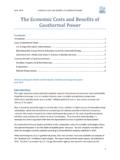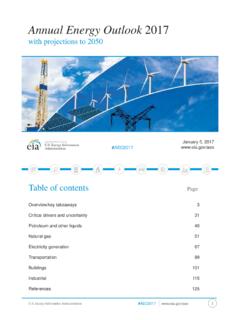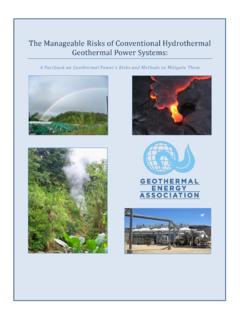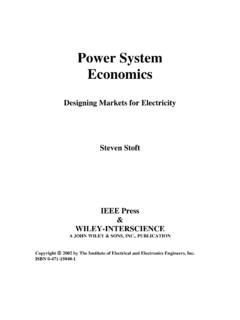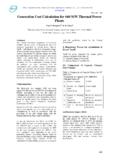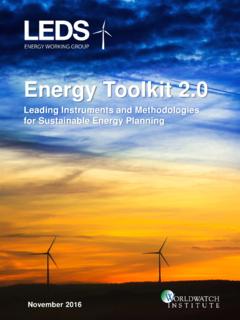Transcription of Simple project evaluation spreadsheet model - World Bank
1 Simple project evaluation spreadsheet model Africa Electricity Institute Practitioner Workshop 15 November 2011 -- Dakar, Senegal Chris Greacen Two very different HOMER Engineers (also project developers, regulators, researchers) Optimizes component selection to minimize levelized cost of energy (LCOE) in hybrid minigrids Excel financial model Financers (also project developers, regulators, researchers) Models cashflow and return on investment Used by: What it does: Simple project viability evaluation model Inputs Outputs project Inputs Revenues Tsh /kwh US c/kwh project Returns Plant Capacity 500 KW Tanesco 87% project IRR Capacity Factor 68% Business 11% Equity IRR Annual Generation 2,978 Mwh Households & Inst.
2 3% project NPV $1,436 # Connections 882 Average Tariff Equity NPV $501 Carbon Revenues Generation Costs USD 000s TSH Mn Operating Costs USD 000s TSH Mn US c /kwh cost recovery Tariff Generation 1,484 2,226 47% Salaries 30 $45 Capital Investments $ / W Soft Costs 670 1,005 21% Maintenance 31 $47 Operating Costs c/ kwh Grid Connection 389 584 12% Fuel Costs 0 $0 Output Per Watt Kwh / W Grid Extension 596 894 19% Other 0 $0 Capital Recovery c/ kwh Total Investment 3,139 4,709 Total Total c/ kwh REA Grants 441 $662 261 TSH / kwh Investment (excl. grants) $2,698 $4,047 Other Inputs Capital Structure USD 000s TSH Mn Schedule 1 2 3 4 Construction Time Years Equity Share 30% Equity 501 751 Construction 67% 33% 0% 0% Collection Efficiency 90% Required returns 15% REA grant 441 662 Operations 0% 67% 100% 100% Distribution losses 5% Loan Rate 15% Loan 2,197 3,296 Tariff inflation Loan Grace Period 3 Other Assumptions CPI Loan Term 15 Depreciation period 20 Years Terminal value times exit FCF WACC** Corporate Tax rate 30% Exchange Rate 1,500 TSH / USD Tax holiday 0 Years Cash Flow $ '000s 1 2 3 4 5 6 7 8 9 10 11 12 13 14 15 Residual Value* Investment $2,093 $1.
3 046 $0 $0 $0 Increase in WC $0 $31 $0 $0 $0 Equity $628 $314 $0 $0 $0 Debt $1,465 $732 $0 $0 $0 Revenue (c/ kwh) Total Revenues $0 $492 $753 $768 $783 $798 $813 $829 $846 $862 $879 $896 $914 $932 $950 Operating Costs $0 $43 $69 $73 $78 $82 $87 $92 $98 $104 $110 $117 $124 $131 $139 Operating Cash flow ($2,093) ($597) $684 $694 $705 $716 $726 $737 $748 $758 $769 $780 $790 $801 $811 Depreciation $0 $157 $157 $157 $157 $157 $157 $157 $157 $157 $157 $157 $157 $157 $157 Loan Payments $0 $0 $0 $513 $513 $513 $513 $513 $513 $513 $513 $513 $513 $513 $513 $0 Interest $0 $220 $363 $417 $403 $386 $367 $345 $320 $291 $258 $220 $176 $125 $67 $0 Principal $0 ($220) ($363) $96 $110 $127 $146 $168 $193 $222 $255 $293 $337 $388 $446 $0 Loan Balance $1,465 $2,417 $2,780 $2,684 $2,574 $2,447 $2,301 $2,133 $1,941 $1,719 $1,464 $1,171 $834 $446 $0 $0 Effective tax $0 $0 $49 $36 $44 $52 $61 $70 $81 $93 $106 $121 $137 $156 $176 $0 Equity CF 38% ($628)
4 $135 $635 $146 $149 $151 $153 $154 $154 $153 $150 $146 $140 $132 $122 $0 DSCR * PV at year 15 for revenues from year 16-25 ** WACC = Equity share * ROE + Debt Share * Loan rate * (1- tax rate) Questions answered by Simple project viability evaluation model How does the financial viability of an off-grid or on-grid SPP project vary under diffent assumptions of tariffs, subsidies, and carbon revenues, exchange rates, Internal Rate of Return (IRR)? project IRR Equity IRR Net Present Value (NPV) project NPV Equity NPV Does cash flow meet debt service requirements? model inputs Input basic project data (yellow cells) Plant Capacity: generation capacity of power plant in kW Capacity factor: ratio of actual output to potential annual output if it operated at nameplate capacity fulltime.
5 # Connections: is applicable to systems that sell electricity to retail customers and receive REA grants of $500 per hookup Investment costs: costs to build project (generator, grid connection, grid extension, etc.) Operating costs: costs to keep project going (salaries, mainteannce, fuel) model inputs (continued) Input basic project data (yellow cells) Construction time: Collection efficiency: portion of tariff that can actually be collected from users. CPI = consumer price index Terminal value = value of equipment at end of 15 years Exchange Rate: value of currency in USD Capital structure (% and rates): equity, loan, etc. Depreciation period: Number of years before asset has zero value Tax holiday: tax holiday is a temporary elimination of a tax as an incentive for businesses to invest.
6 model outputs Operating cash flow: cash generated from sales, minus cash paid out to cover operations costs Depreciation: A reduction in the value of power plant with the passage of time, due in particular to wear and tear Loan payments: installments paid by the SPP to the lender Loan balance: the amount owed, including principal and interest; Effective Tax: Tax paid divided by taxable income Equity cash flow: Cash flow left over after depreciation, loan payments, and taxes Debt Service Coverage Ratio (DCSR): the amount of debt that can be supported by the cash flow generated from the project . model outputs (continued) Input basic project data (yellow cells) WAAC: Weighted average cost of capital. # Connections: is applicable to systems that sell electricity to retail customers and receive REA grants of $500 per hookup Collection efficiency: portion of tariff that can actually be collected from users.
7 CPI = consumer price index Terminal value = value of equipment at end of 15 years Thank you For more information, please contact chrisgreacen (at) Excel file used here available at: Using HOMER to evaluate the levelized costs of different mini-grid generation options Africa Electricity Institute Practitioner Workshop 15 November 2011 -- Dakar, Senegal Chris Greacen HOMER: Hybrid Optimization model for Electric Renewables Developed by National Renewable energy Laboratory (NREL) of US Department of energy (DOE). Download free: Rural Electrification: Classics Historically, the primary means of providing power have been through grid extension and diesel generators. Grid Extension: Very high initial cost , poor cost recovery, time intensive (generation, transmission, distribution) and usually must be subsidized.
8 Most often used. Diesel Generators: Inexpensive installation but expensive to operate, environmental damage/pollution, and subject to volatile fuel costs and availability. Hybrid Systems - Another option A hybrid energy system consists of two or more renewable energy sources used together to provide increased system efficiency as well as greater balance in energy supply. Higher Reliability (?) Hybrids reduce daily & seasonal resource variations .. but more more parts to break. Lower cost of energy Hybrids reduce daily & seasonal resource variations Minimizes battery size and fuel usage Existing Diesel & Distribution System Investment Questions HOMER answers How much of which technologies to use? diesel, solar, wind, biomass, hydro Fuel consumption, runtime, project economics?
9 How do these answers depend on assumptions? Fuel price, interest rates, equipment costs, utility tariffs Electric and thermal load shapes, reliability requirements and load management Resource quality and availability Sensitivities variations in prices, resource availabilty Illustrating HOMER using Koh Po, Thailand Households: 150 location: Krabi, Southern, Thailand coordinates: 7 32' 0" North, 99 8' 0" East How to model with HOMER How to model with HOMER Load Load 8760 hours Resources: Solar Resources: Wind Diesel inputs PV: inputs Generator: inputs Converter (inverter): inputs Battery: inputs Results Search space Results Thank you For more information, please contact Chrisgreacen (at) HOMER file used here available at.










